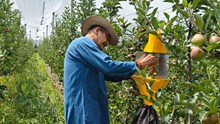
Bajra, or pearl millet (Pennisetum glaucum), is one of the most important and widely cultivated cereal crops in India, especially in states like Rajasthan, Maharashtra, Gujarat, Haryana, and Uttar Pradesh. Renowned for its exceptional drought tolerance and ability to thrive in poor soils, bajra plays a crucial role in ensuring food and fodder security for millions of small and marginal farmers. Its richness in iron, protein, and dietary fiber makes it not just a staple grain but also a key pillar of nutrition and sustainability in rural India.
As the demand for climate-smart and high-yielding hybrids grows, companies like Shakti Vardhak are innovating to offer superior seed solutions tailored to farmers’ real-world needs. Among these, Yodha Plus Hybrid Bajra emerges as a robust performer combining early maturity, high tillering, and excellent disease resistance to support higher productivity and resilience under stress conditions.
Yodha Plus Hybrid Bajra: A High-Yielding Performer from Shakti Vardhak
Among the promising innovations in the millet seed sector is Yodha Plus Hybrid Bajra, a superior hybrid developed by Shakti Vardhak Hybrid Seeds Pvt. This hybrid has been specifically bred to meet the challenges of modern millet farming, offering high yield potential, disease tolerance, and robust agronomic performance. Here’s what sets Yodha Plus apart:
Unique Agronomic Characteristics
-
Plant Height: The crop grows vigorously, reaching a height of 300 to 310 cm, offering both grain and fodder utility. Its tall stature makes it ideal for dual-purpose use in grain production and livestock feed.
-
Tillering Capacity: Yodha Plus Bajra produces 10–12 productive tillers per plant, ensuring uniform development and significantly boosting yield per unit area.
-
Flowering and Maturity: It reaches 50% flowering in 50–55 days, and matures in just 85 to 90 days. This makes it a relatively short-duration crop, allowing for better crop planning and adaptability in multiple cropping systems.
-
Ear Head Quality: The hybrid is known for its 30–35 cm long, compact, and cylindrical ear heads. This uniform ear development ensures easy harvesting and reduces post-harvest losses.
Superior Tolerance and Field Resilience
-
Lodging Resistance: Thanks to its strong stem architecture, Yodha Plus is tolerant to lodging, even under high winds or heavy rainfall. This stability is particularly valuable for farmers in regions with unpredictable weather patterns.
-
Leaf Quality: It features dark green, broad leaves, which not only aid in better photosynthetic efficiency but also enhance its fodder value.
-
Disease Resistance: One of the standout traits of Yodha Plus is its tolerance to downy mildew, a major disease affecting bajra crops. This resistance reduces the need for chemical interventions and ensures healthy crop stands.
Complete Cultivation Guide for Yodha Plus Bajra
Land Selection
For successful cultivation of Yodha Plus Hybrid Bajra, selecting the right type of soil is critical. This hybrid performs best in sandy loam soil that provides good aeration and drainage. Such soils allow roots to develop deeply and uniformly, supporting robust plant growth.
It is important to avoid waterlogged fields, as stagnant water can damage root systems, promote disease, and hinder nutrient uptake. Ensuring well-drained conditions from the beginning can greatly improve the crop's performance throughout its growth cycle.
Sowing Time
Timing is essential for maximizing the yield of bajra. Sowing should be carried out between June 15 and July 15 in irrigated areas, which aligns with optimal climatic conditions for germination and early growth. In rainfed areas, farmers should wait for the arrival of the first monsoon rains, which naturally provide the required moisture for seed germination. Sowing at the right time ensures better establishment of seedlings and reduces the risk of crop failure due to drought or excessive rain later in the season.
Seed Rate
The recommended seed rate for Yodha Plus Hybrid Bajra is 1.5 to 2.0 kg per acre, which ensures an ideal plant population density. Using this rate helps in achieving uniform crop stand and avoids issues like overcrowding or under-planting.
Seed Treatment
One of the convenient advantages of Shakti Vardhak’s seeds is that they come pre-treated with fungicides, insecticides, and bio-fertilizers. This eliminates the need for farmers to undertake separate seed treatment processes, saving both time and effort.
The treatment protects the seeds during their early stages from fungal infections, soil-borne pests, and nutrient deficiencies, thereby improving germination rates and seedling health.
Method of Sowing
For optimal plant growth, farmers should maintain a row-to-row distance of 45 cm and a plant-to-plant distance of 15 cm. This spacing provides each plant with ample room to grow, reduces competition for nutrients and water, and allows better sunlight exposure and airflow, which helps in controlling pests and diseases. Correct sowing methods also facilitate easy intercultural operations and improve harvesting efficiency.
Irrigation
While bajra is known for its drought tolerance, timely irrigation significantly enhances crop performance, particularly in dry spells. The most critical stages where irrigation should be provided include bud break, flowering, and grain formation, as water stress during these phases can reduce yields substantially.
However, farmers must avoid using saline or brackish water, which can harm the plants and degrade soil quality over time. Rainwater or freshwater sources should be prioritized wherever possible.
Intercultural Operations and Weed Control
Weed management is essential during the early growth stages of bajra to reduce competition for nutrients and moisture. An effective practice is to apply 400 grams of Atrazine 50 WP mixed in 150 liters of water per acre immediately after sowing to prevent weed germination. Additionally, tilling the soil 25 to 30 days after sowing is advisable to remove emerging weeds and better aeration of soil.
Fertilizer Application
Fertilizers should ideally be applied based on soil testing to match the crop’s exact nutrient requirements. In the absence of a soil test, farmers can follow this recommended dose per acre:
|
Fertilizer |
Irrigated Area (kg) |
Rainfed Area (kg) |
|
Urea |
125 |
35 |
|
D.A.P |
50 |
20 |
|
Arboite Zinc |
3 |
3 |
|
Potash |
20 |
- |
Apply the full quantity of D.A.P., potash, and zinc at the time of sowing to support early plant development. Urea should be applied in three stages: half at sowing, one-fourth 25–30 days after sowing, and the remaining one-fourth at the grain formation stage for better crop output and grain quality.
Pest Control – Hairy Caterpillar
The hairy caterpillar is a common pest in bajra fields and can cause significant damage if not managed early. For effective control, farmers should spray 200 ml of Monocrotophos (Monosil/Nuvacron) or 500 ml of Quinalphos 25 EC (Ekalux) mixed with 200 liters of water per acre. This treatment should be applied as soon as caterpillars are noticed to prevent widespread leaf damage and crop loss.
Disease Control – Green Ear Disease (Jogiya)
Green ear disease, also known as Jogiya, is a major disease that affects ear development in bajra, leading to malformed or sterile ears. To manage this, farmers are advised to spray 500 grams of Mancozeb (Indofil M-45) mixed in 200 liters of water per acre. Early and timely application of fungicide can prevent the disease from spreading and protect the yield potential of the crop.
Farmer Testimonials: Performance-Built Trust
Kishan Singh, Farmer - Bikaner, Rajasthan
"Yodha Plus is the most excellent bajra I have planted in my 15 years of farming. It flowered early, and I got a harvest in just 85 days. The tillering was wonderful, and even my cattle enjoyed the green fodder galore."
Manoj Patel, Farmer - Jalgaon, Maharashtra
"I switched to Yodha Plus on the recommendation of my seed dealer. What impressed me most was the uniform ear heads and the crop’s standing strength during a windy spell in August. No lodging at all. I’ll be using it again next season."
Sunita Devi, Farmer - Aligarh, Uttar Pradesh
"We used to fight diseases in bajra, but this hybrid has fixed so many problems. It fought the green ear disease, yielded well, and needed less spraying. Even my neighbors are now requesting this seed."
Why Farmers Prefer Yodha Plus Hybrid Bajra
The adoption of Yodha Plus Hybrid Bajra is steadily growing among progressive farmers due to its consistent performance in the field. Its combination of early maturity, high tillering, disease resistance, and suitability for varied agro-climatic zones makes it a reliable choice for maximizing productivity while minimizing risk.
Moreover, It supports sustainable farming goals by thriving in water-scarce areas and reducing dependency on chemical inputs. For farmers seeking both food and fodder security, Yodha Plus is a dependable solution backed by the trust and quality assurance of Shakti Vardhak Hybrid Seeds Pvt. Ltd.
In the evolving landscape of Indian agriculture, where climate resilience and productivity are equally critical, hybrid bajra varieties like Yodha Plus by Shakti Vardhak are bridging the gap between tradition and innovation. With its agronomic strengths and farmer-centric benefits, it exemplifies how scientific seed development can transform staple crops into engines of rural prosperity. For farmers aiming to improve their yields without compromising on sustainability, Yodha Plus Hybrid Bajra offers a promising path forward.
















